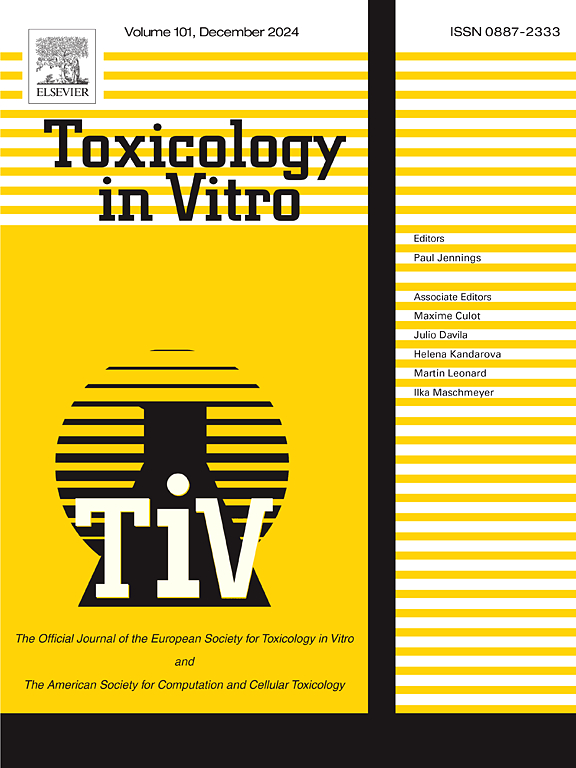羟氯喹微粒体代谢的物种差异
IF 2.6
3区 医学
Q3 TOXICOLOGY
引用次数: 0
摘要
羟氯喹(HCQ)是一种以抗疟疾和抗自身免疫特性而闻名的药物,它很容易受到药物-药物相互作用(ddi)的影响,特别是那些涉及细胞色素P450酶(CYPs)的相互作用。不同物种间HCQ的药代动力学和代谢谱还没有很好的表征。在本研究中,我们比较分析了HCQ在人肝微粒体和各种临床前动物模型中的代谢和药代动力学。代谢物分析表明,单氧化代谢物M5主要在小鼠(MLM)、大鼠(RLM)、狗(DLM)和猪(PLM)的微粒体中产生。相反,另外两种氧化代谢物M4和M6仅在PLM中产生。利用人类CYP亚型的选择性抑制剂,我们确定了HLM中不同于其他物种的关键酶。此外,HLM的代谢途径与其他物种不同。在HLM中,已经确定了两种代谢途径,每种途径都包括两步反应。CYP2D6、CYP2C8、CYP3A4和CYP1A1是参与HCQ代谢的关键酶,HCQ对CYP2D6、CYP2C8和CYP1A1具有明显的底物抑制作用。我们的工作为选择合适的实验动物模型来准确评估HCQ的体内过程及其在多药方案中的潜力提供了新的思路。本文章由计算机程序翻译,如有差异,请以英文原文为准。

Species differences in microsomal metabolism of hydroxychloroquine
Hydroxychloroquine (HCQ), a medication renowned for its anti-malarial and anti-autoimmune properties, is susceptible to drug-drug interactions (DDIs), particularly those involving cytochrome P450 enzymes (CYPs). The pharmacokinetic and metabolic profiles of HCQ across species are not well-characterized. In this study, we conducted a comparative analysis of HCQ metabolism and pharmacokinetics in human liver microsomes and those from various preclinical animal models. Metabolite profiling indicated that the mono-oxidized metabolite M5 was predominantly produced in microsomes from mouse (MLM), rats (RLM), dogs (DLM), and pigs (PLM). Conversely, two other oxidative metabolites, M4 and M6, were uniquely generated in PLM. Utilizing selective inhibitors of human CYP isoforms, we identified key enzymes in HLM that differ from those in other species. Furthermore, the metabolic pathways in HLM were distinct from those observed in other species. In HLM, two metabolic pathways have been identified, each comprising a two-step reaction. CYP2D6, CYP2C8, CYP3A4, and CYP1A1 are the key enzymes involved in HCQ metabolism, with HCQ demonstrating significant substrate inhibition of CYP2D6, CYP2C8, and CYP1A1. Our work shed a new light on selection of suitable experimental animal models for accurate evaluation of HCQ's in vivo processes and its potential in multi-drug regimens.
求助全文
通过发布文献求助,成功后即可免费获取论文全文。
去求助
来源期刊

Toxicology in Vitro
医学-毒理学
CiteScore
6.50
自引率
3.10%
发文量
181
审稿时长
65 days
期刊介绍:
Toxicology in Vitro publishes original research papers and reviews on the application and use of in vitro systems for assessing or predicting the toxic effects of chemicals and elucidating their mechanisms of action. These in vitro techniques include utilizing cell or tissue cultures, isolated cells, tissue slices, subcellular fractions, transgenic cell cultures, and cells from transgenic organisms, as well as in silico modelling. The Journal will focus on investigations that involve the development and validation of new in vitro methods, e.g. for prediction of toxic effects based on traditional and in silico modelling; on the use of methods in high-throughput toxicology and pharmacology; elucidation of mechanisms of toxic action; the application of genomics, transcriptomics and proteomics in toxicology, as well as on comparative studies that characterise the relationship between in vitro and in vivo findings. The Journal strongly encourages the submission of manuscripts that focus on the development of in vitro methods, their practical applications and regulatory use (e.g. in the areas of food components cosmetics, pharmaceuticals, pesticides, and industrial chemicals). Toxicology in Vitro discourages papers that record reporting on toxicological effects from materials, such as plant extracts or herbal medicines, that have not been chemically characterized.
 求助内容:
求助内容: 应助结果提醒方式:
应助结果提醒方式:


